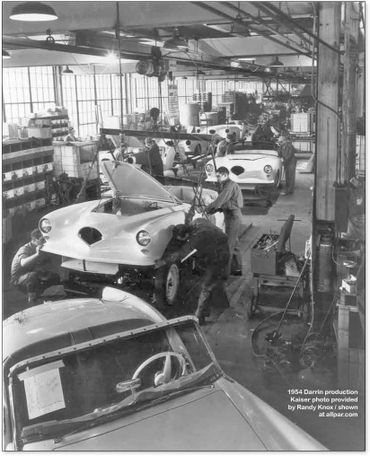1954 Kaiser Darrin
More Darrin








About
Howard “Dutch” Darrin had been a noted designer years before the thought of building a fiberglass sports car ever entered his mind. In fact, some of the most beautiful Packards ever built were a product of his genius. One styling signature Darrin consistently included in his designs was the sweeping fender line that led to the "dip" at the front of the rear fenders, which gave the Packard Darrin roadsters of the early '40s a stunning look.
Actually, the Kaiser Darrin was to be one of Howard's last design achievements, some say the crowning jewel of his career.
Darrin had an on again, off again relationship with the Kaiser Frazer Corporation, a product of his interactions with Henry Kaiser. Time after time, clay designs he had put his heart into had been literally "thrown by the wayside".
At the time, his latest frustration had been the Henry J, a rather boxy little compact and the "old man's" pet project (Hence the name). Darrin was sure that a lot better looking car could be built on the J chassis, and he was going to prove it! Using his own money, and without any knowledge of Kaiser, Dutch set out to accomplish that very task. Having heard of the tremendous accomplishments Bill Tritt had made using the medium of glass reinforced plastic (G.R.P.) in sports car bodies, Darrin enlisted the Glasspar Company to cloth up a prototype of his clay design he built during the first half of 1952.
With the master like Tritt, the beautiful little car emerged as something to be greatly admired. The most notable aspects by far on the little beauty were its sliding pocket doors (Dutch held a patent since 1946 on these) and three position Landau convertible top. The only disappointment was the little F head six, which was the conventional Henry J engine.
When the prototype was all finished, Dutch decided to invite the Kaiser's down to his shop in Santa Monica for a look. As he had figured. when the old man got a look at it, he came unraveled. He told him, "We are not in the business of building sports cars", and he thought Darrin had a lot of audacity for proceeding with the project without any authorization. Darrin told Kaiser in no uncertain terms that the project was not done on company time and was funded with Darrin's own money. "Furthermore, if you don't build the car under the Kaiser banner, I'll build it myself."
Unfortunately for old Henry, he had brought along his wife, who stepped in at this time and interjected "This is the most beautiful thing I have ever seen, I don't see why you aren't in the business of building sports cars, Henry? I don't think there will be many automobile companies that won't go into the sports car business after seeing this car!" Well, that made it another matter for Mr Kaiser. By the end of the viewing, Henry had not only bought the idea of building a sports car, but gave Darrin the go ahead on a 4 door prototype based on the same sliding door concept. Months later, Kaiser showed his appreciation to Dutch by overruling the K.F. executives and gracing the project with the name Kaiser-Darrin.
Glasspar was again approached to build the Darrin bodies, but was only involved in a handful of cars. Best records show only eight. Production models were done in-house and numbered 435.
By the end of 1954, the Darrin project was terminated. This was due in major part to the fact that the company was suffering financially, as were all the small American auto companies. Around 50 of the 435 were stored in the Willys' plant storage lot, when an unseasonably early freak snow storm hit and buried them. They weren't dug out until several months had passed. The cars were deemed too deteriorated to sell as new, and an edict was sent from management that they should be scrapped. When Dutch got wind of this, he was floored. He ranted that nobody was going to scrap his creations. To appease him, Darrin was allowed to purchase them for scrap value. He did, and immediately removed the lot to his shop in Santa Monica. It wasn't until the project's demise with Kaiser that Darrin thought about breathing new life into the little car with its sliding doors. He altered some of the 50 in an attempt to generate interest. The most notable of these were six that were retrofitted with Cadillac Eldorado engines. Lance Reventlow was purported to have owned and raced one of these.
The Kaiser Darrin and its designer Howard "Dutch" Darrin, rank most prominently in the history of the early American sports cars. The design and creativity that went into this vehicle is without a doubt a tribute to good old American ingenuity and boundless creativity.
FREDERICK J. ROTH
Copyright June 2003
